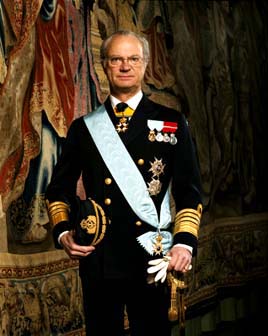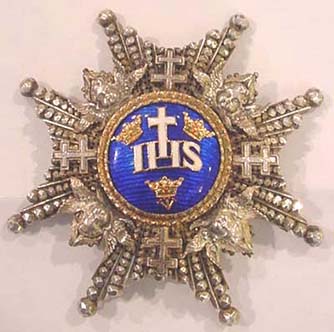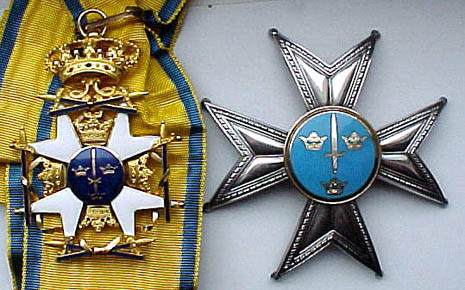
H.M. King Karl XVI Gustaf
Sweden

H.M. King Karl XVI Gustaf
Grand Master of
Royal Order of the Seraphim - Established: 23 February 1748 by King Frederick I of Sweden, together with the Order of the Sword and the Order of the Polar Star. After the reorganization of the orders in 1975 the order is only awarded to foreign heads of state and members of the royal family (the last non-royal Swedish holder was Sten Rudholm). The order has only one class with the dignity of Knight (Member for women and Member of the Cloth for clergymen), and is the foremost order of Sweden.
When originally instituted the knights of the Order were required to supervise the major hospitals and mental asylums in Sweden, and in particular, the Seraphim Hospital, which was a major hospital in Stockholm until it was closed in 1980. This requirement evidentually died out as boards of physicians and other professionals made such supervision by the Knights of the Seraphim anachronistic during the course of the 19th century.
Motto: Iesus Hominum Salvator

Order of the Polar Star - Established: 23 February 1748 by King Frederick I of Sweden, together with the Order of the Sword and the Order of the Seraphim.
The Order of the Polar Star was until 1975 intended as a reward for Swedish and foreign "civic merits, for devotion to duty, for science, literary, learned and useful works and for new and beneficial institutions".
This is to prove that Sweden is as constant as a never setting star. The Order's colour is black. This was chosen so that when wearing the black sash, the white, blue and golden cross would stand out and shine as the light of enlightenment from the black surface. Women and clergy men are not called knight or commander but simply as Member (Ledamot).
After the reorganization of the orders in 1975 the order is only awarded to foreigners and members of the royal family. It is often awarded to foreign office holders (such as Prime and Senior Ministers) during Swedish state visits.
Motto: Nescit Occasum (it knows no decline)

Royal Order of the Sword - Established: 23 February 1748 by King Frederick I of Sweden, together with the Order of the Seraphim and the Order of the Polar Star.
Awarded to officers, and originally intended as an award for bravery and particularly long or useful service, it eventually became a more or less obligatory award for military officers after a certain number of years in service. There were originally three grades, Knight, Commander and Commander Grand Cross, but these were later multiplied by division into classes.
In 1788 king Gustav III created two new grades of the order, which could only be bestowed in war time, and those are;
These grades proper were only given to commissioned officers, but an affiliated decoration, the Svärdstecken ("Badge of the Sword"), introduced in 1850, was given to non-commissioned officers; one thus decorated would call himself a svärdsman ("Sword man").
In 1952 a special medal of distinction was added to the order. These could only be bestowed in wartime. They are the War Cross of the Order of the Sword in Gold and in Silver. They come in the same ribbon as the order, and it is a medal struck in gold or silver, with an upraised sword in the center on the front.
The order is no longer awarded since 1975, but technically it still exists. His Majesty King Carl XVI Gustaf of Sweden frequently wears his Commander Grand Cross necklet and badge.
Motto: Pro Patria (For Fatherland)
